This Manual-Swapped Ferrari 458 Speciale Rethinks the Modern Supercar
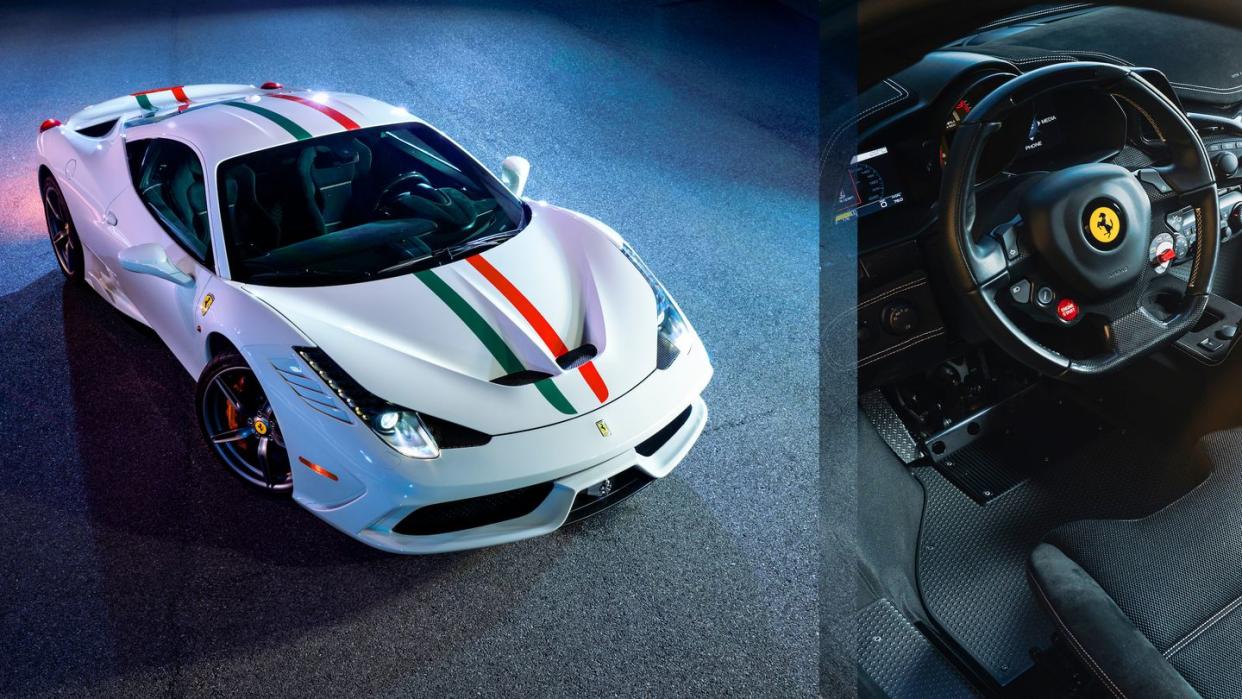

Don’t ask Jeff Segal to build you one. The amount of time, money, and effort it took to put a manual transmission into a Ferrari 458 Speciale was so great, the longtime Ferrari sports-car racer never wants to do it again. If you want one, this is the only one, and you’ll have to make an offer Segal can’t decline.
It's the work of Modificata, a company founded by Segal dedicated to building tweaked, race-inspired F355s and 360s. It isn’t a typical resto-modder like, say, Singer. There’s no shop. It’s just Segal leveraging his extensive contacts list garnered from years of being in the motorsport and Ferrari worlds, sending cars to the best people he knows to make something new.
Segal says he wanted to see what Ferrari's greatest modern road car, its ultimate naturally aspirated V-8, would be like with a manual transmission rather than its standard seven-speed dual-clutch. It’s the ultimate “what-if?” question. It led to “why not?” and it turns out there’s a very good answer for that.

The hardware was the easy part, though “easy” is relative. Segal is coy on specifics, as he wants to keep the ability to do this exclusive to Modificata, but he does say that all the parts are Ferrari-sourced. The gearbox itself has a cable-operated shift and given that Ferrari ditched shift rods for cable linkages for the 360 Modena and F430, this gives you a general idea of where at least some of the parts come from. Going manual necessitated ditching the 458’s electrotonic limited-slip differential for a traditional mechanical unit, though the super-light flywheel is the standard Speciale part.
When looking at the transmission from above, through the open engine cover, nothing looks out of place. Yet Segal points out that there’s a lot less hardware compared with a standard car, and the mounting points for the transaxle are unique. The polished shift knob is the same used on several Ferrari models Nineties and Aughts Ferrari models, though the gated pattern and center console are naturally bespoke to fit the 458 cockpit. The gorgeous pedal box is an AP Racing item sourced from a 458 GT3 car, which like all modern GT race cars has a clutch pedal.
Trialing the right combination of components to fit and feel right was an effort, though nothing compared to the electronics.
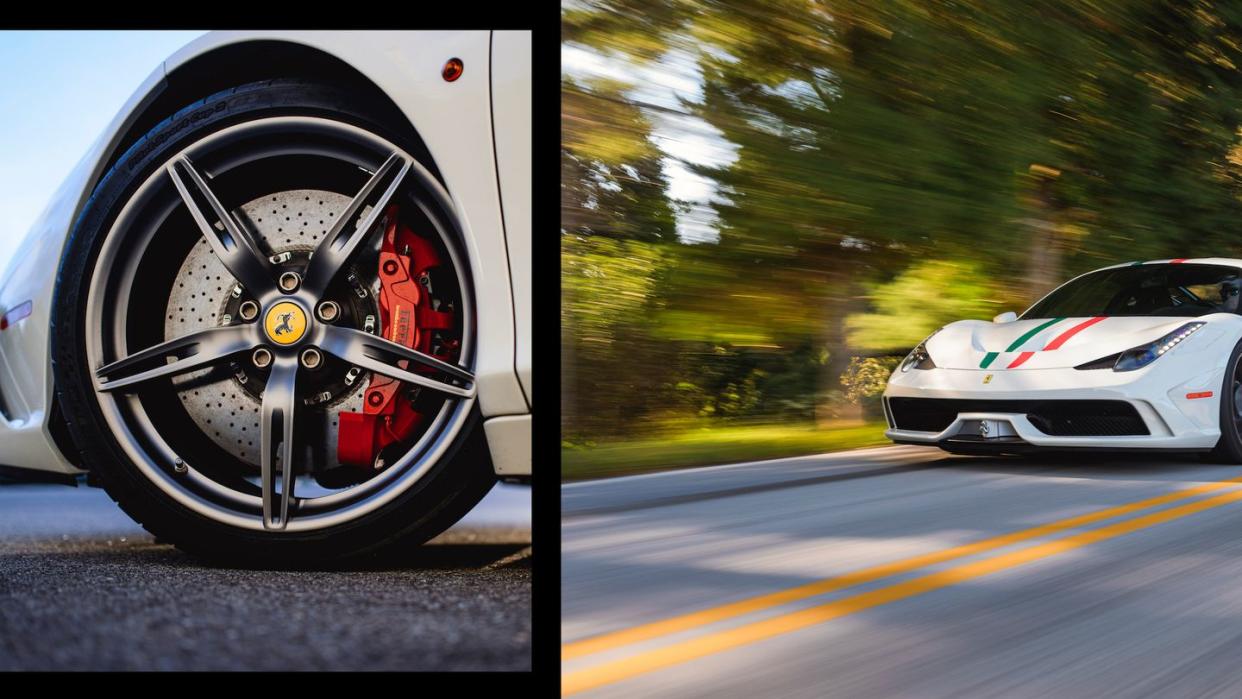
“In any modern car where you have all kinds of systems speaking to all other systems, you can’t have the car be unhappy,” Segal explains. “You have sensors that are waiting to see that the front trunk is closed before it will allow the parking brake to be released. So, any little seemingly unimportant detail matters to the car, and I think that's what took the time, care, and attention.”
Essentially, you have to figure out what signals the car is looking for from all its disparate components and make sure that those signals are present and being sent to the right places. Even if you put an entirely different transmission in the car. It’s not just bolting in some new parts and calling it a day—it’s reverse engineering the entire software system. Something that’s perhaps even more challenging in a Ferrari than other cars of similar vintage.
The 458 was one of the first Ferraris where many of the car’s various systems—engine, gearbox, magnetorheological dampers, brakes, differential, traction/stability control—all influence one another to define driving dynamics. Clever electronic wizardry designed to make the driver feel like a superhero. It’s a field that Ferrari’s pioneered, and in its day the 458, especially the Speciale, was way ahead of the curve. So, you can understand why I was somewhat astonished that Segal’s manual 458 moved forward under its own power.
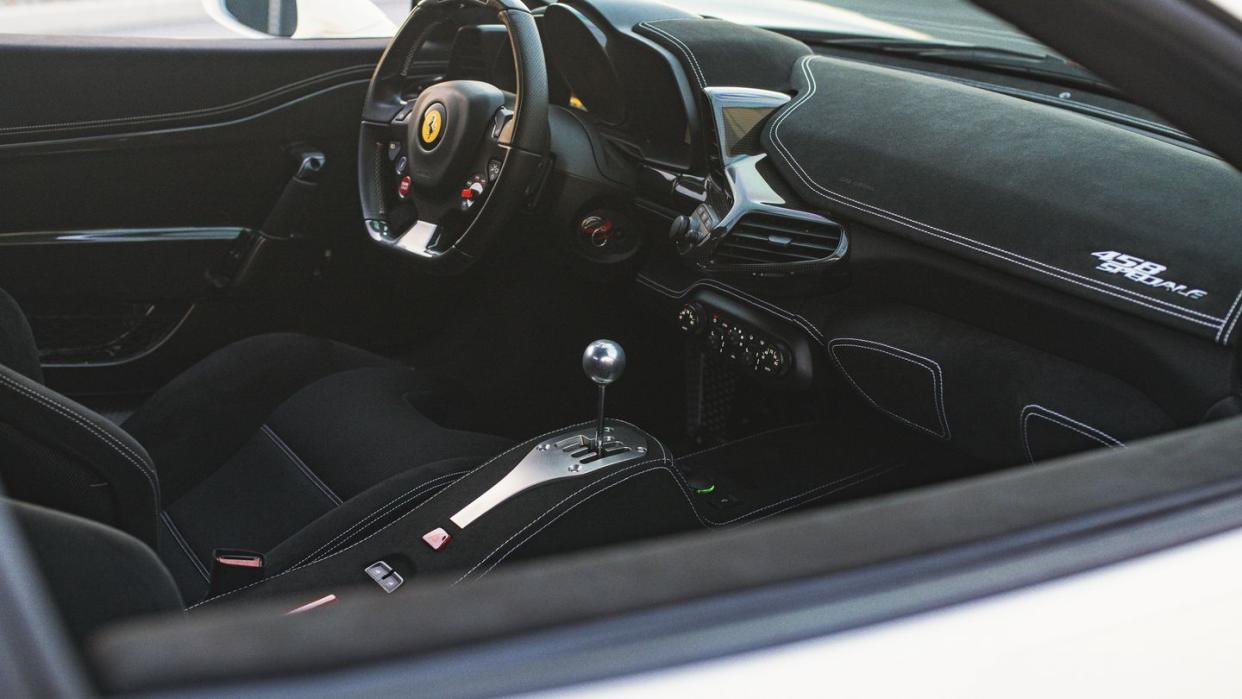
Not only does it work, it works beautifully. The car essentially doesn’t know that the driver is shifting gear with a stick and cables. It just sees what gear you’re in. Leave it in neutral and an “N” lights up on the dashboard; slot it into 1st and let out the clutch, and “1” flashes up. And so on. There are no check-engine lights, no limp home modes, no ABS failures, no excuses. The drive-mode selector works as standard, changing engine and traction/stability-control mapping. The car even holds the brakes for you on a steep hill.
Segal opted for a road-car clutch here, and that makes maneuvering the 458 much easier. Unlike a race car, you don’t have to slip the hell out of it just to get it moving. There’s not a lot of clutch travel, and unlike most modern cars, the pedal is floor hinged. If you’ve driven an air-cooled Volkswagen or Porsche, it should feel very familiar. It’s light and the bite point is very clearly defined, too. A little bit of throttle and a gentle release on the pedal, and you’re off. Easy.
It takes a few miles to get keyed into the engine’s ultra-quick response. Revs rise and fall quickly, so you need to be fast with your changes, but like all Ferrari manual boxes, you can’t bully the shifter from gate to gate. Be firm, not aggressive. Cable linkages are never quite as satisfyingly hefty as their metal-rod counterparts, but this shifter is still very precise. And you get classic Ferrari gated metal click-clack as you move across the neutral plane.
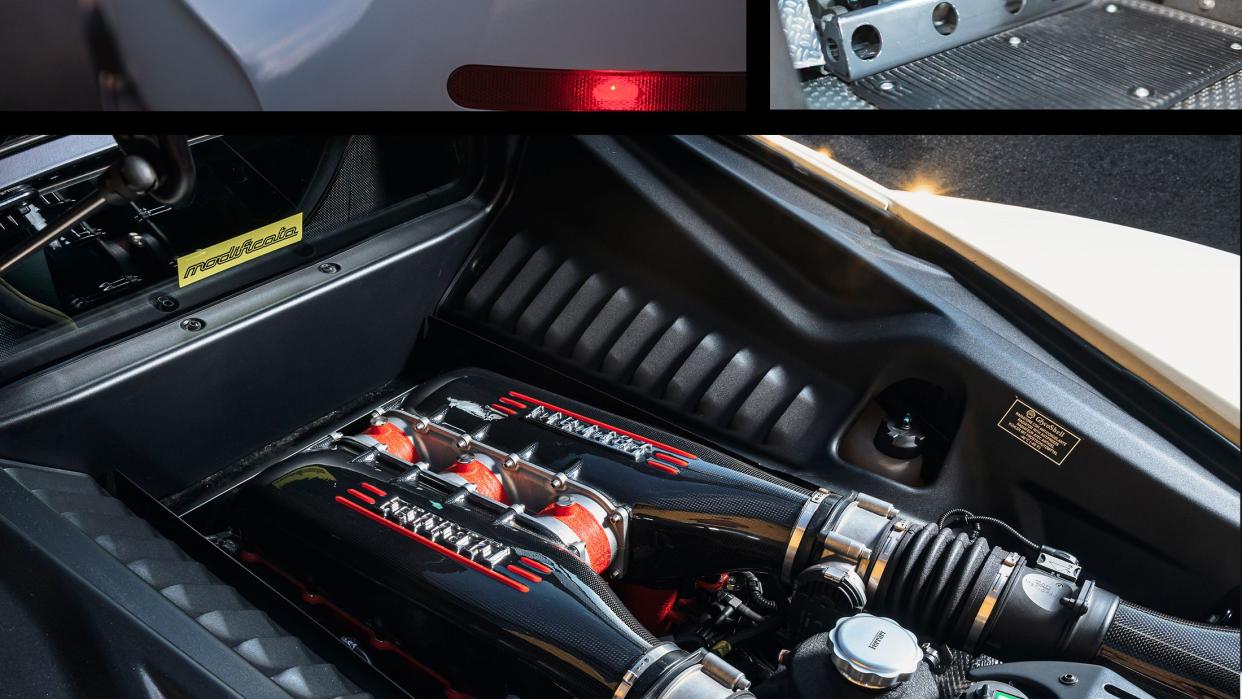
Modificata wasn’t able to alter the throttle mapping for the 4.5-liter V-8, and that’s perhaps the car’s biggest drawback. It presents itself when you blip the throttle for a downshift. Sometimes you get a soft response, sometimes you get exactly what you’re looking for. It’s not really an issue if you keep the revs above 5000, but that’s not really possible in slow, everyday driving.
You have to remain focused to shift smoothly in this car. Relax too much and you’ll fluff all your changes. It’s a big contrast to a lot of modern manual cars that do so much for the driver to the point that you can mindlessly shift with two fingers. This 458 keeps you on your toes, involved in the process at every step.
The best thing about the car is that it’s still a 458 Speciale. In other words, one of the all-time great supercars. The engine is a monster, with tons of torque from low revs and an incredible rush to its 9000-rpm power peak. Five-hundred ninety-seven horsepower is a damn impressive figure from an N/A V-8 even if the new Corvette Z06’s 5.5-liter offers 670. The Ferrari counters with an extraordinary 14:1 compression ratio and the way it revs isn’t like much else out there. And the manual unlocks new ways of interacting with the thing.
The chassis is pretty much perfect. Dial up race mode but set the dampers to their "Bumpy Road” setting and the Speciale glides across the surface with remarkable compliance and control. Turn-in grip is as ferocious as we’ve come to expect with a modern Ferrari, and the steering, while light, is perfectly weighted and micron precise. Driving this car fast on a country road is intense, all the more so as you constantly throw gears at it and concentrate to make sure your downshifts are perfect. It’s approachable to a point but be clumsy getting back to throttle after an upshift and you’re quickly reminded of what 597 hp to the rear wheels means. At least I was.
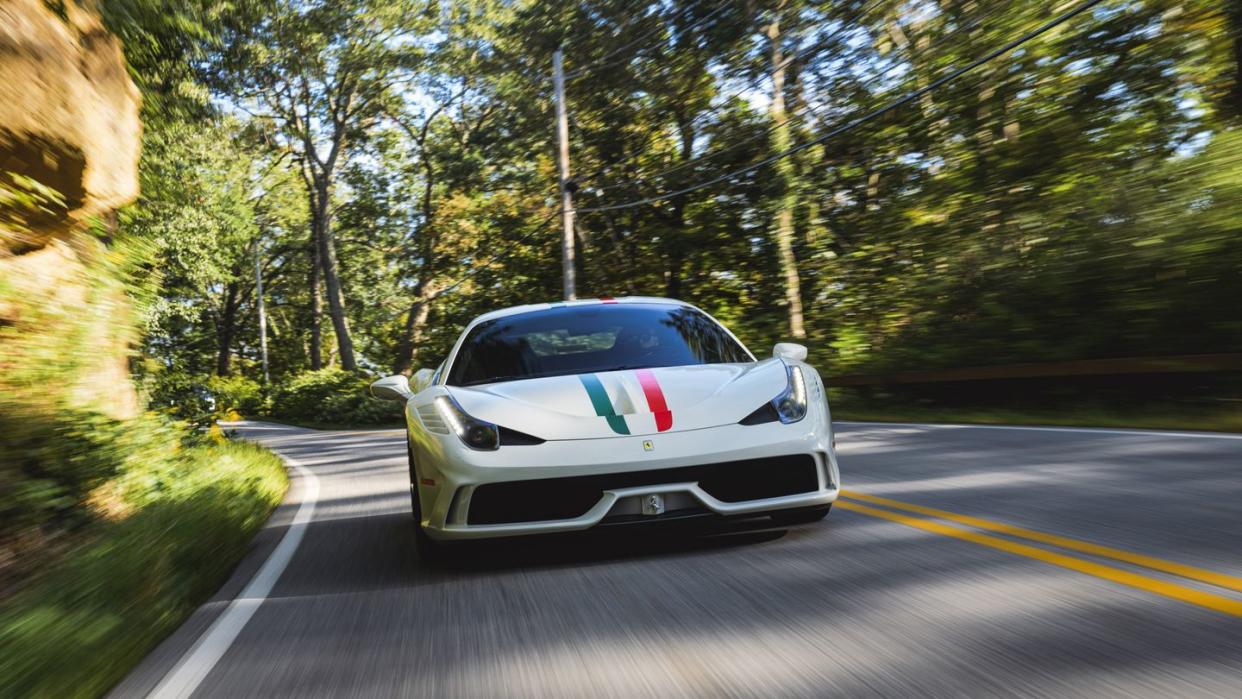
Another quirk of the conversion is the removal of power brakes. There wasn’t a way to package a booster with this pedal box, as the steering column is in the way, so this car does without. Segal warns that the pedal is heavy, but it doesn’t require a stomp like a race car, and the feel you get through your right foot is unmatched. It’s a non-issue if not an upgrade.
On the road, I didn't miss the electronic differential, and Segal thinks the mechanical unit makes the handling even better. When you’re at the limit, you may want the extra assistance provided by the e-diff, though it’s hard to say without actually being there. I think this shows the fundamental strength of the Speciale’s chassis—it doesn’t need to hide behind electronic aids to shine.
Driven sedately, you could use this car every day. Driving hard is probably best done in small doses, however. It’s all encompassing, one of the greatest driving experiences I’ve ever had. Cars don’t get much more engaging.
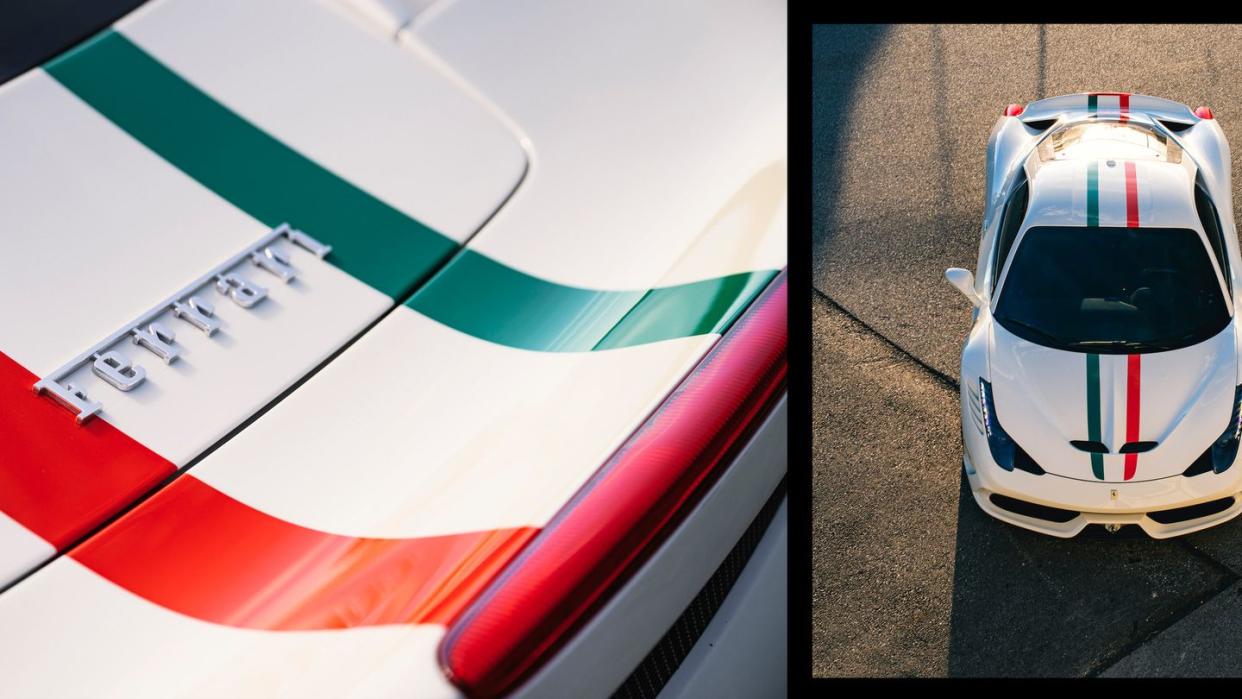
Segal loves Ferraris. While we stand around as our shooter Dave Burnett takes the photos you see here, we nerd out about the brand's modern classics. Segal's particularly excited about a bizarre, ratty, right-hand drive F355 he brought to the U.S. with rare carbon-fiber interior trim, racing brakes, and all sorts of other unobtanium parts to be harvested for future Modificata builds. He adores the 458 Speciale, and couldn't help wondering what it would be like with a manual. He's probably not alone, but he is the guy who can do what it takes to answer that question.
Ferrari is a particularly interesting automaker. Since the company's transition into its modern era starting in the Nineties, its engineers have concerned themselves with pushing the limits of technology, not spending too much time wallowing in the past. Automated transmissions are central to doing this. Not just because they shift faster, or because they bring a tie into racing, but because they help push the whole car forward technologically. When Ferrari does nostalgia, as with the Monza SP1 and SP2 and Daytona SP3 limited-runs, it does so within a specific set of parameters. Their spirit may be of the old school, but the tech never strays from what's current across the rest of the lineup. These cars pay tribute to past models, but aren't retro in the slightest.
One imagines Ferrari could make a ton of money doing a new, manual car. (Automotive YouTube omnipresence Doug DeMuro recently made a very compelling argument to this effect.) Just look at what people are willing to pay for the latest, greatest manual-transmission Porsche models. But doing so could be seen as a step backwards, a break from Ferrari's current positioning.
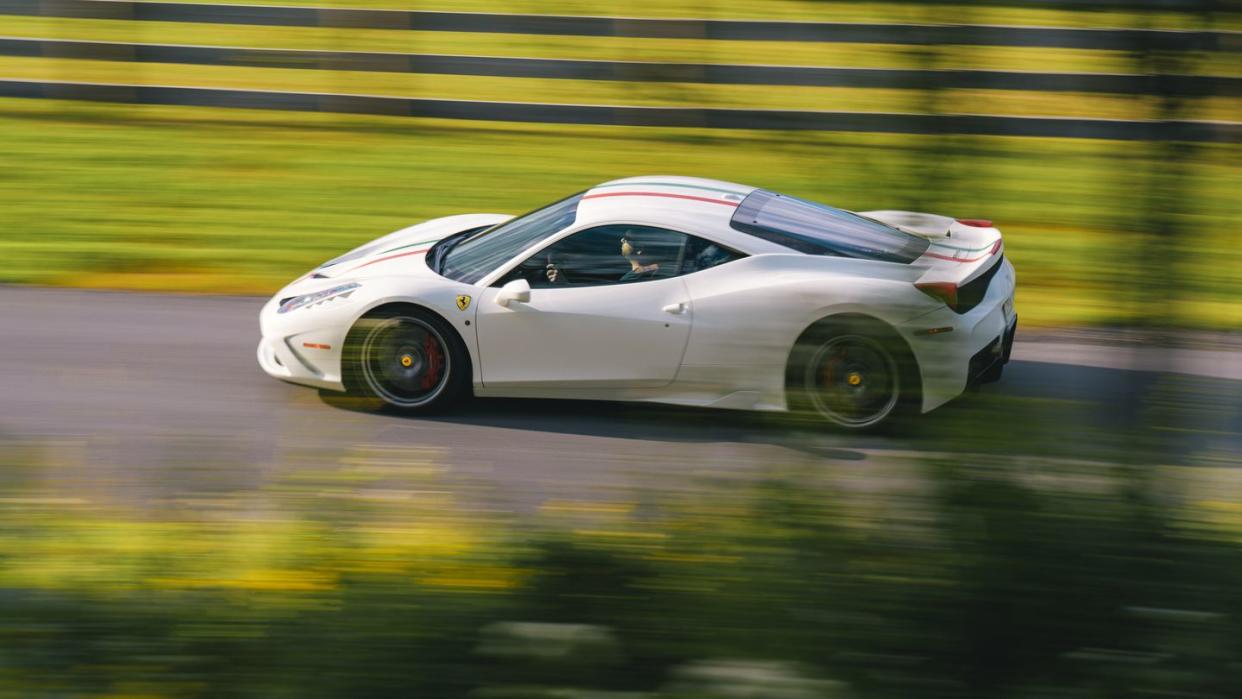
This isn't just an seemingly insurmountable technical challenge—it's a reimagining of what a modern Ferrari could be. Which, of course, is Modificata's raison d'etre, but with a 458 Speciale, the stakes are so much higher than with a F355 or 360 Modena. How dare you question Ferrari?
Segal wishes it wasn't this way. He wants Modificata to show that you don't have to be so precious with a Ferrari. There's a way to do things with them to bring out new character, while honoring their original spirit. This car is proof.
Too bad he won't make another.

A car-lover’s community for ultimate access & unrivaled experiences.JOIN NOW Hearst Owned
You Might Also Like
